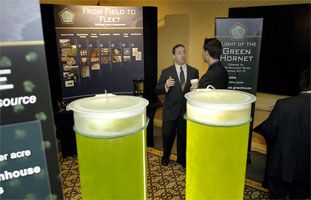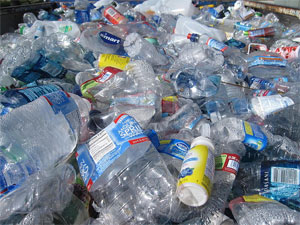Our world is facing a global energy crisis. As we continue to deplete non-renewable energy resources, we must seek to develop alternative renewable resources to meet our energy demands. Scientists and engineers are currently researching algae as a potential source of biofuel that might replace fossil fuels as a main source of energy. Compared to other biofuel options, algae have a much higher yield of energy per area per time, a greater speed of proliferation, and an ability to proliferate successfully in many different environments. Further, because algae grow through photosynthesis, which consumes carbon dioxide, algal growth could be fed by industrial carbon emissions, thus reducing overall emissions and thereby slowing global warming. Deterrents to large-scale algae cultivation for use as fuel are its highly expensive production and comparatively high costs of the fuel after it is processed. If its production and sale could be made to be economically competitive with other forms of energy, algae biofuel would certainly become an important energy source that will fuel the world to a greener future.
The Power of Pond Scum
Could oil ever become green? The domestic and global energy crisis has accelerated alternative energy research; scientists and engineers are currently scrambling to develop realistic substitutes for current non-sustainable energy sources. One largely unpublicized option among proposed clean, renewable energy sources are algae. With developing technology and increasing public interest, pond and pool scum may be the key to pulling out of our energy crisis, saving our planet, and preserving our lifestyles.
“That goo in my pool has a name?”
Yes, and it is called algae. Algae are a large and diverse group of eukaryotic (nucleus-containing) organisms. It is estimated that there are over 30,000 species of algae, ranging in color from lime green to black [1]. Like plants, algae are photosynthetic, meaning they use solar energy to convert carbon dioxide into organic compounds. Requiring only water, carbon dioxide, and light to grow, algae readily proliferate; thus, ponds and swimming pools often fall victim to unwanted colonies of these visitors (see Fig. 1). Though the algae we often refer to as scum may seem to be no more than a slimy nuisance, they have immense potential to be developed into usable energy.
To begin, there are three general classes of algae: emergents (which grow in swamps), macroalgae (like seaweed), and microalgae, (which are the type that can be manipulated to produce the kinds of oil that could potentially solve our energy problems) [2]. More specifically, the National Renewable Energy Laboratory (NREL) considers about 300 species of microalgae as potentially good sources for harvesting oil. There are 4 main groups of microalgae: diatoms, green algae, blue-green algae, and golden algae. Besides creating a diverse color palette, each of these microalgae groups has advantages that make it uniquely useful when considering it a fuel source.
Algae as Fuel? – Not Such a Novel Concept
Though it may seem cutting edge, producing oil from algae is not a new idea. As far back as the early 1950s, experiments in producing mass cultures of microalgae were conducted on rooftops at MIT, in one of the first projects utilizing algae as biofuel. Then, with the onset of America’s oil and energy crises in the 1970s, the study of algae biofuels was revisited in the hopes of developing a useful alternative source of oil [3]. However, research on algae biofuel was abandoned to focus on ethanol, resulting in the 1995 closure of the Aquatic Species Program, the US Department of Energy program that focused on developing algae fuel. A resurgence of interest has been seen in recent years in light of the ever-increasing monetary and environmental costs associated with fossil fuels. Without substantial government funding, most developments in the field now come from research at universities and private companies, mostly in Arizona and southern California.
From Goo to Gasoline
How does it work? On a small scale, the process of producing biofuel from algae is as simple as a grade school science fair experiment. Using a plastic bag as a “reactor” and algae as his feed stock, entrepreneur Jim Sears conducted a rudimentary experiment to see if algae could be mass produced with a similar design. The experiment was a success [4]. The fact that such a basic experiment had so much success shows how versatile and simple algal culture can be. Basically, algae employ the process of photosynthesis, where carbon dioxide from the air combines with water and light to produce oxygen and carbohydrates.
By taking in sunlight and carbon dioxide in the presence of water, algae produce lipids to store the energy, in a process similar to fat production and storage in the human body. From there, a simple chemical process can be applied to liquefy the solid lipids, converting them to oil. This oil can be used directly, or can be further processed and converted into biodiesel for use in automobiles [5].
Man vs. Nature
Though the process is simple in theory, obstacles lie in the task of controlling the algae’s growth and harvesting its products efficiently. There are two main options for algae cultivation, the open pond system and photobioreactors.
The open pond system, the simpler method, involves manipulating the algae in its natural environment and harvesting the oil it produces through its own unaided growth. The open pond system is inexpensive compared to mechanized alternatives, but it is also slow, prone to contamination, and generally more successful for alga species with lower oil contents, and thus, not ideal.
Photobioreactors (PBRs) essentially take the open pond system and cover it, making it a “closed pond”, or a closed system. Containers for photobioreactors are usually translucent, as they must allow in sunlight for photosynthesis to occur and for algae to proliferate (see Fig. 2). Chambers that are not translucent require a light source. In one type of photobioreactor, triangular polyethylene chambers house the algae, which are fed by carbon dioxide bubbled into the system [1]. Because their conditions can be controlled, PBRs are used to cultivate more species of algae than open ponds, especially alga species with higher oil contents. In the same way, these controlled systems can be operated year-round without being subject to the effects of seasonal climate change that could damage the productivity of an open system. On the other hand, photobioreactors are very expensive and require careful maintenance to ensure optimal productivity. Also, all feed sources must be supplied externally, further raising the cost of PBRs.
Why Goo is Great – Algae as an Attractive Alternative
Obviously, algae fuel competes with many other renewable biofuel energy sources such as ethanol fuel and biomass. So what distinguishes algae fuel as a superior option? Like other biofuel options, a reliance on algae fuel will reduce the United States’ dependence on foreign oil. An inconsistent supply of oil could lead to wild price fluctuations, soaring especially in the summer months. Alternative fuels, such as algae, produced domestically are more secure and subject to fewer transportation costs, allowing the price to be more stable.
Algae have a few other unique features that can give it an advantage over other biofuels. Most notable are the alga’s size and its ability to proliferate. Marine algae are the most efficient organisms on earth for absorbing light energy, yielding 5 to 10 times more bioenergy molecules per area per time than any other plant source [5]. Generally, up to half of an alga’s body weight is oil, meaning algae have very high yields. Theoretically, algae would produce 10,000 gallons of oil per acre per year, while soy, canola, and palm oils produce 50, 150, and 650 gallons per acre per year, respectively [1]. Also, algae’s reproductive capabilities are unparalleled; algae can double in weight several times per day, according to the US Department of Energy [6]. Because of algae’s remarkable proliferation ability, oil from algae could be harvested every day, unlike plant sources (such as soybeans or corn) whose harvesting is delayed by seasonal cycles.
The production of algae fuel also has beneficial environmental effects. Algae feed on carbon dioxide, the hazardous greenhouse gas that contributes to global warming. With our carbon footprint becoming more pronounced, and the need to reduce carbon emissions becoming more immediate, any process that reduces, rather than creates, carbon emissions is highly beneficial. Because the amount of carbon dioxide in the atmosphere is not large enough to elicit exponential growth from algae, engineers have proposed the idea of collecting carbon emissions from sources such as coal power plants and directly feeding them into an algae fuel-producing facility. This economical and environmentally-friendly form of recycling would both reduce carbon emissions into the atmosphere and create the ideal conditions for algae growth.
The requirements for the growth of algae are also environmentally advantageous. A large portion of the tens of thousands of species of algae can thrive in both fresh water and brackish water, thus reducing the limitations on proliferation sites. Further, unlike other crops algae do not require large fields that demand fresh water irrigation; they could simply be farmed on flooded land (UPI). In addition to this, the cultivation of algae for fuel will not infringe on the world’s food supply because algae are not a human food source like corn or soybeans. Even byproducts from algae fuel production can be applied; after extracting the oil from algae, a nutrient-rich, paste-like substance remains that could be marketed as fertilizer [2].
Why Goo Gets Booed
Despite its attractive qualities, developing fuel from algae has had little large-scale success. Current technology and production methods are simply not economically viable. Although algae grow under a variety of conditions, to reap the benefits, algae proliferation must be maximized by controlling extremely sensitive factors such as water temperature and pH. The kind of careful maintenance necessary to operate PBRs can be quite difficult and expensive, which seriously inhibits large-scale production. To meet even a small fraction of fuel consumption needs, large-scale algae production would require more expensive materials, larger site areas in more advantageous climates, and more operators skilled in facilitating the cultivation and production processes. Furthermore, the processing of algae-produced oil into biodiesel is a highly expensive and complicated technical process called transesterification, which reduces the oil’s viscosity so that it can be directly used in diesel engines. Because of its highly technical and expensive nature, there is currently no commercial-sized plant producing biodiesel in the United States. Currently, biodiesel from algae would cost approximately $21 per gallon, which is clearly not marketable compared to the relatively cheap price of gasoline [7]. To become more competitive, algae fuel would simply need to reduce its extremely high production costs. An initial solution to this problem could be to pay algae farms to rid both industrial of unwanted substances like carbon dioxide and wastewater that feed the algae production [7].
Algae’s Bottom Line
Algae will never fully replace oil, but in the midst of today’s global energy crisis, alternative fuel sources are being pursued more vigorously than ever. However, with limited public knowledge and limited governmental financial support, the development and production of algae as a source of biofuel is stunted. Furthermore, the current financial recession will make it more difficult to elicit much enthusiasm for the cultivation of mass quantities of algae. Despite its current economic drawbacks, it seems feasible that with further developments in efficiency, that unwanted pool scum may one day contribute to fueling our country.





